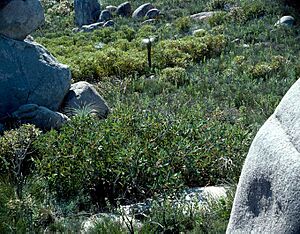Woolbernup mallee facts for kids
Quick facts for kids Woolbernup mallee |
|
|---|---|
 |
|
| Flowers and buds of Eucalyptus acies on Mount Manypeaks | |
| Scientific classification | |
| Genus: |
Eucalyptus
|
| Species: |
acies
|
The Woolbernup mallee (scientific name: Eucalyptus acies) is a special type of shrub. It grows in a bushy, spreading way and is found only in a small area of Western Australia. This plant has smooth bark, leaves shaped like a spear, and flower buds that look like clubs. When it blooms, it has creamy white flowers. After flowering, it produces fruit that are shaped like a half-sphere or a bell.
Contents
What the Woolbernup Mallee Looks Like
The Woolbernup mallee is a type of mallee shrub. This means it has many stems growing from the ground, instead of just one main trunk like a tree. It usually grows to be about 1.5 to 3 meters (5 to 10 feet) tall. Its bark is smooth and grey.
When the plant is young, its leaves are arranged in pairs. They are oval-shaped, about 5 to 7 centimeters (2 to 3 inches) long and 3 to 5 centimeters (1 to 2 inches) wide. The underside of these young leaves is a lighter green.
As the plant gets older, its leaves become thicker and tougher. They are shaped like a spear (lance-shaped) and are about 9 to 13.5 centimeters (3.5 to 5.3 inches) long and 2 to 3.5 centimeters (0.8 to 1.4 inches) wide. These adult leaves are a shiny green on both sides. They grow on a flat stalk called a petiole, which is about 2 to 3 centimeters (0.8 to 1.2 inches) long.
Flowers and Fruit
The flowers of the Woolbernup mallee grow in groups of up to seven. They appear where the leaves meet the stem, on a flat stalk called a peduncle. This stalk is about 1.7 to 2.3 centimeters (0.7 to 0.9 inches) long.
Before they open, the flower buds look like clubs. They are about 1.5 to 2.1 centimeters (0.6 to 0.8 inches) long and 0.7 to 1.1 centimeters (0.3 to 0.4 inches) wide. The part of the flower that holds the petals (called the flower cup) has clear ridges. It is usually much longer than the cap that covers the bud (called the operculum).
The flowers have creamy white stamens, which are the parts that produce pollen. The Woolbernup mallee blooms from September to November. After the flowers, the plant produces fruit. These fruits are shaped like a half-sphere or a bell. They are about 1 to 1.5 centimeters (0.4 to 0.6 inches) long and 1.2 to 1.6 centimeters (0.5 to 0.6 inches) wide.
How the Woolbernup Mallee Got Its Name
The scientific name Eucalyptus acies was first officially described in 1972 by a scientist named Ian Brooker. He found a sample of the plant on a hill called Woolbernup, which is in the Fitzgerald River National Park.
The second part of its scientific name, acies, is a Latin word. It means "the point or edge of a weapon." This name was chosen because the young branches of this plant have angled, sharp-looking edges.
Where the Woolbernup Mallee Lives
The Woolbernup mallee is found only in a specific part of Western Australia. It grows in low shrubland and heath areas. You can find it on hills made of quartzite (a type of rock) and among granite boulders. These areas are close to the coast, between the towns of Bremer Bay and Hopetoun.
Conservation Status
The Western Australian Government's Department of Parks and Wildlife has looked at the Woolbernup mallee. They have classified it as "not threatened." This means that currently, there are enough of these plants, and they are not in danger of disappearing.



